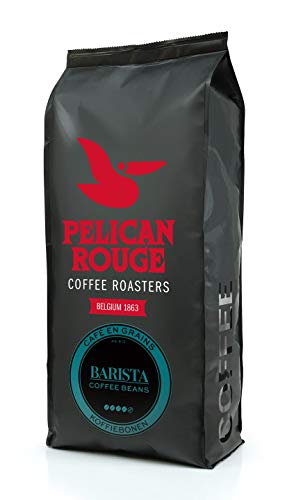Coffee Bean Types: Arabica, Robusta, Liberica, and Excelsa
If you're a coffee enthusiast, you likely already know that different types of beans have different flavor profiles. Learn more about four of the most popular varieties: Arabica, Robusta, Liberica, and Excelsa.
Excelsa beans, a type Liberica which is grown exclusively in Southeast Asia. They have a more fruity, tarter flavor profile and are often used in blends of coffee to add depth.
Arabica

Arabica is the most sought-after coffee in the world accounting for 75% of global coffee beans produced. Arabica beans are sweeter and milder in flavor than Robusta and are available in a variety profiles. The flavor and aroma of coffee is affected by the conditions in which it is grown and the processing methods employed.
The word "coffee" actually comes from the Arabic word for berry and coffee beans are actually fruit seeds that are cultivated inside bright red berries. It is believed that the ancient Ethiopian shepherds noticed that their goats were energized by eating these berries. The cultivation of coffee spread quickly across the globe.
Coffee beans can flourish at high altitudes, and thrive in cold temperatures and lots of rain. This is the reason Arabica coffee is considered to be the most delicious kind of coffee.
Many specialty coffee roasters and shops are focused on using ethically-sourced arabica beans and focusing on fair pay for farmers and sustainable farming practices. These companies typically blend arabica beans to make unique coffees that can be used in various methods of brewing. Blending is a way to control the aroma, flavor, body and acidity of coffee. It is generally used to create an even and balanced taste that is appealing to a broad audience.
Robusta
Robusta beans are the second most coveted type of coffee bean in the world. They have more caffeine per bean and are more protected against diseases and pests. They also contain higher levels of chlorogenic acids, which are naturally occurring antioxidants. However, these acids may cause oxidation in the coffee brewing process and can cause undesirable flavors.
The plant itself is more robust than arabica and is able to grow in less favorable climate conditions and at lower elevations. It can tolerate warmer temperatures and thrives in direct sunlight. It produces more coffee per plant, and it grows faster than arabica. This makes it a more cost effective crop to grow.
Although it might appear counterintuitive Robusta beans are typically blended with arabica beans to create coffee blends. If you find names such as Uganda or Kenya on a coffee bag it's possible that there's also some robusta.
While some roasters exclusively use arabica beans, the majority use mix both varieties to lower costs and preserve quality. To preserve the integrity of flavor it is recommended to select the highest quality beans from a trusted source. This can be accomplished by purchasing your beans directly from farmers.
Liberica
Liberica beans have a shape that is similar to a football that makes them different from other coffee beans. They are characterized by a smell that is fruity, floral and smokey. They are often added to other coffee bean varieties to create an extra, stronger flavor.
Liberica coffee beans are available in West Africa, Malaysia (Borneo), and Southeast Asia. They can be found at low altitudes and can withstand humid, hot climates. They are also more resistant to disease than Arabica or Robusta.
These qualities make them ideal for home-growing. On the internet, you can purchase the seeds from various sources. However, it is best to buy the beans from local producers to ensure quality. The best growing conditions for Liberica coffee plants are fertile deep volcanic soils, with a moderately acidic pH and sufficient annual rainfall.
Excelsa is a different variety of coffee bean. It was initially classified as a distinct species, but has been reclassified as a Liberica variant. These oval-shaped coffee beans are grown on large coffee plants, which can grow to 20 to 30 feet in height at medium altitudes. Their distinctive flavor is tart and sour, making them a popular option for blends that are house-made. They are also lighter in flavor and caffeine than Arabica and Robusta and Robusta, yet they have a distinct depth of flavor.
Excelsa
Excelsa coffee beans aren't as popular as Arabica and Robusta, even though they are the fourth most popular. In fact they were considered to be an individual species of coffee plant until 2006 when they were changed to an alternative to Coffea liberica var. dewevrei. They are produced in Southeast Asia today and account for 7 percent of the world's production of coffee. These coffee beans are shaped as teardrops and have a dark, mysterious taste. They're frequently used in blends to add extra body and a full, tart, ripened fruit flavor.
Arabica beans are the most popular and are known for having a sweeter taste. They grow best at high altitudes, and they thrive in warm tropical climates. They also have a hint of acidity. If they are brewed correctly and roast properly they may have notes like chocolate, nuts or even fruit.
Robusta is a close second only to Arabica and makes up around 40% of the world's coffee. Robusta beans are smaller and rounder, but have twice as much caffeine as Arabica. They also have more bitterness than the other two varieties and are more likely to have woody and earthy overtones.
After you've learned about the four most commonly used types and their characteristics, it's time to select your favorite brew. If bulk buy coffee beans looking to enjoy a smooth mild flavor, go for an arabica or a blend of arabica and robusta beans.
